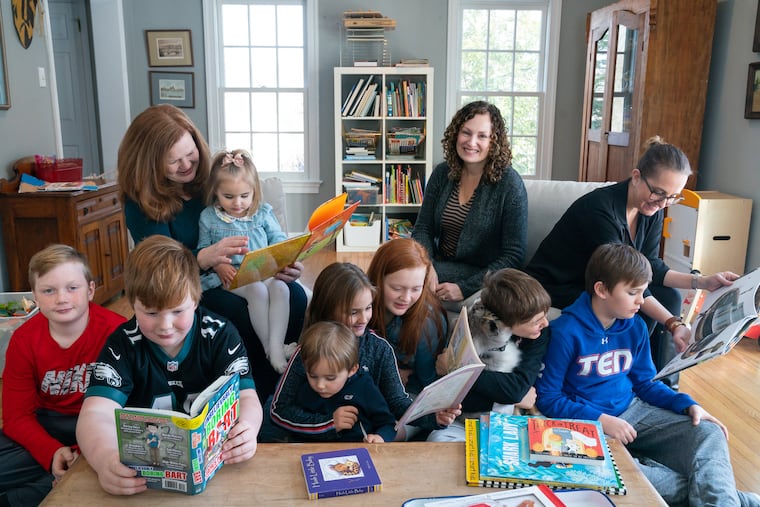Hooked on phonics? Not in this school district, and parents say the result is kids can’t read.
So they've launched a grassroots effort called Everyone Reads T/E that crusades for the Tredyffrin/Easttown School District to employ a phonics-based approach to teach reading.

When Kate Mayer moved to the Philadelphia suburbs from Chicago nearly four years ago, she chose to live in one of the state’s best school districts, Tredyffrin/Easttown, so that her two children with dyslexia would get the help they needed.
But she was surprised to discover that children who struggled to read did not get much time for special instruction. Nor was she happy with how reading was taught.
“I realized that what [my children] needed was tough to get, even in a fancy public school district,” said Mayer.
Soon she met other mothers who shared her views that the Main Line district seemed indifferent toward students with dyslexia, and used outdated teaching methods.
Today, the grassroots effort she formed with Jamie Lynch and Wendy Brooks, called Everyone Reads T/E, is a prod and occasional thorn in the side of Tredyffrin/Easttown administrators as it crusades for teachers to employ new methods, and serves as a lifeline for a growing number of frustrated parents.
As word spread about Everyone Reads T/E, the moms began to hear from parents in Radnor, Council Rock, and other districts. They now want to form a regional group to trade information about a rising debate over how reading is taught.
In an email, Wendy Towle, the district’s director of curriculum, instruction, staff development, and planning, said, “We have strong instructional practices in place” to teach reading, which includes some phonics and phonemic awareness.
She promised the district would provide more information about its literacy programs at a March 14 school board meeting.
For U.S. children, reading scores from the National Assessment of Education Progress, or NEAP, have remained flat for more than two decades, with more than 60 percent of fourth graders still rated as not proficient.
The lack of progress has sparked a long-running debate over two teaching methods — the dominant “balanced literacy” approach, which argues that children learn reading by immersing themselves in books, vs. “structured literacy,” the theory that kids need to connect letters with their sounds before they can understand words.
The 2000 National Reading Panel mandated by Congress said evidence showed children’s reading proficiency improved when they were taught through phonics.
But advocates say teachers and administrators have been slow to react to the new evidence. Many were trained in the 1980s and ‘90s when the “whole language” method was in vogue. Diane Reott, executive director of the Pennsylvania Branch, International Dyslexia Association, said colleges “are not teaching how … kids learn to read.”
In Tredyffrin/Easttown, Mayer, Lynch, and Brooks said their initial goal was to connect teachers in the Chester County district with the best evidence about classroom methods but got "pushback” from administrators.
In the wake of their efforts, Tredffryin/Easttown this year is partnering with AIM Institute for Learning & Research for 19 reading and special-ed instructors to learn the Orton-Gillingham method, rooted in phonics.
Meeting recently at a Panera Bread in Devon, the parents swapped stories about how their frustration with the district’s refusal to acknowledge their kids’ dyslexia brought them together.
Now, they said, Tredyffrin/Easttown reading specialists and psychologists are better at acknowledging dyslexia. So, they have moved beyond dyslexia-related issues to seek “structural change” in how reading is taught to all students — and are helping other parents.
Debbie Kuch said her eldest daughter began receiving reading support in school after experiencing learning difficulties such as reversing letters. When the girl began having behavioral problems in fourth grade, Kuch said, the district refused to give her an individualized education program, or IEP, but said the child should see a therapist.
Kuch got involved in Everyone Reads T/E to help advocate for her daughter.
The strategy adopted by Everyone Reads T/E is part of a national movement, with parents elsewhere in the country facing similar issues.
Monica McHale-Small is an adjunct professor at Temple University who pushed for more phonics-based learning when she was superintendent of the Saucon Valley School District, and saw test scores rise. She said growing concern that schools are failing to diagnose dyslexia has sparked legislation in 44 states, pushing for pilot studies or requiring a phonics-oriented approach.
Pennsylvania enacted legislation in 2014 for a pilot program in early literacy education that has expanded to nine districts — none around Philadelphia — with results expected soon. Some districts aren’t waiting for the findings. In Bethlehem, a 2015 move to phonics-based learning saw the percentage of kindergarteners passing a reading benchmark climb from less than half to 84 percent.
The Tredyffrin/Easttown debate is colored by awareness that many parents in the largely affluent district have resources to send struggling kids to a tutor or pay tuition at private schools that focus on learning disabilities. “My children who have dyslexia have passed over the reading struggle, because we have gotten them support,” Mayer acknowledged.
Traci Sill, a tutor in the phonics-based Wilson learning system who sees many kids from Tredyffrin/Easttown, is a big supporter of Everyone Reads T/E.
“Parents need that backup and assurance that this isn’t just happening to your child — it’s happening a lot,” she said. “Parents are now realizing that we have to do something.”